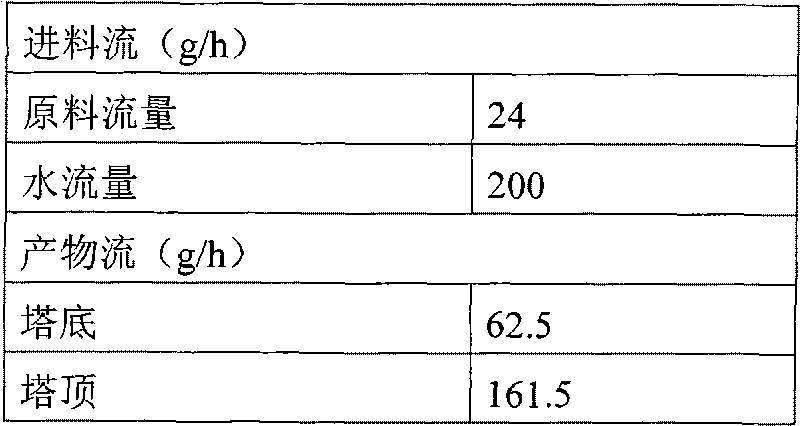Device and method for preparing butane diacid by continuously hydrolyzing dialkyl succinate ester
A technology of dialkyl succinate and succinic acid, applied in the preparation of carboxylate/lactone, organic chemistry, etc., can solve the problem of large sewage discharge, accelerated resin saturation, production scale and application constraints of succinic acid And other issues
- Summary
- Abstract
- Description
- Claims
- Application Information
AI Technical Summary
Problems solved by technology
Method used
Image
Examples
Embodiment 1
[0035] The raw material is pure dibutyl 1,4-succinate
[0036] 1,4-dibutyl succinate inlet: 4
[0037] Reactive distillation tower temperature: 210°C
[0038] Reaction tower pressure: 1.9MPa
[0039] Reaction tower kettle temperature: 190°C
[0040] Steam generator temperature: 190°C
[0041] 1,4-dibutyl succinate conversion rate: close to 100%
[0042]
[0043] The bottom stream composition (weight percent) at the bottom of the tower:
[0044] 1,4-dibutyl succinate: close to 0.0%
[0045] 1,4-Monobutyl succinate: close to 0.0%
[0046] 1,4-dibutyl succinate: 25.80%
[0047] Water: 74.20%
[0048] The top stream composition (percentage by weight) at the top of the tower:
[0049] Butanol: 6.43%
[0050] Water: 93.57%
Embodiment 2
[0052] The raw material is pure dibutyl 1,4-succinate
[0053] 1,4-dibutyl succinate inlet: 4
[0054] Reactive distillation tower temperature: 190°C
[0055] Reaction tower pressure: 1.2MPa
[0056] Reaction tower kettle temperature: 190°C
[0057] Steam generator temperature: 190°C
[0058] 1,4-dibutyl succinate conversion rate: close to 100%
[0059]
[0060] The bottom stream composition (weight percent) at the bottom of the tower:
[0061] 1,4-dibutyl succinate: close to 0.0%
[0062] 1,4-Monobutyl succinate: close to 0.0%
[0063] 1,4-Succinic acid: 22.94%
[0064] Water: 77.06%
[0065] The top stream composition (percentage by weight) at the top of the tower:
[0066] Butanol: 5.36%
[0067] Water: 94.64%
Embodiment 3
[0069] The raw material is pure dibutyl 1,4-succinate
[0070] 1,4-dibutyl succinate inlet: 3
[0071] Reactive distillation tower temperature: 190°C
[0072] Reaction tower pressure: 1.2MPa
[0073] Reaction tower kettle temperature: 190°C
[0074] Steam generator temperature: 190°C
[0075] 1,4-dibutyl succinate: close to 100%
[0076]
[0077] The bottom stream composition (weight percent) at the bottom of the tower:
[0078] 1,4-dibutyl succinate: close to 0.0%
[0079] 1,4-Monobutyl succinate: grade 0.0%
[0080] 1,4-Succinic acid: 48.58%
[0081] Water: 51.42%
[0082] The top stream composition (percentage by weight) at the top of the tower:
[0083] Butanol: 8.26%
[0084] Water: 91.74%
PUM
 Login to View More
Login to View More Abstract
Description
Claims
Application Information
 Login to View More
Login to View More - R&D
- Intellectual Property
- Life Sciences
- Materials
- Tech Scout
- Unparalleled Data Quality
- Higher Quality Content
- 60% Fewer Hallucinations
Browse by: Latest US Patents, China's latest patents, Technical Efficacy Thesaurus, Application Domain, Technology Topic, Popular Technical Reports.
© 2025 PatSnap. All rights reserved.Legal|Privacy policy|Modern Slavery Act Transparency Statement|Sitemap|About US| Contact US: help@patsnap.com



